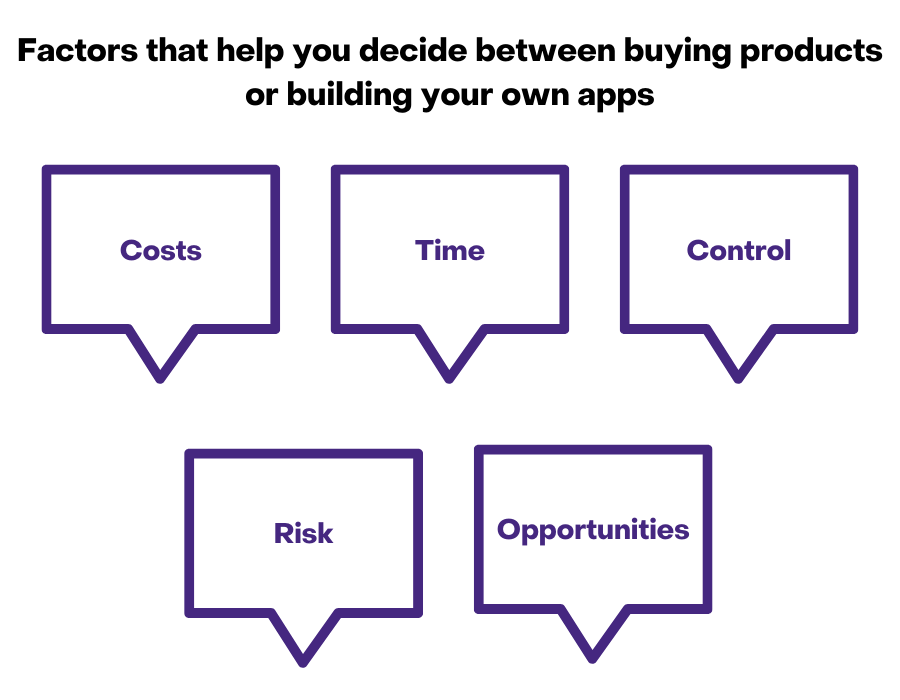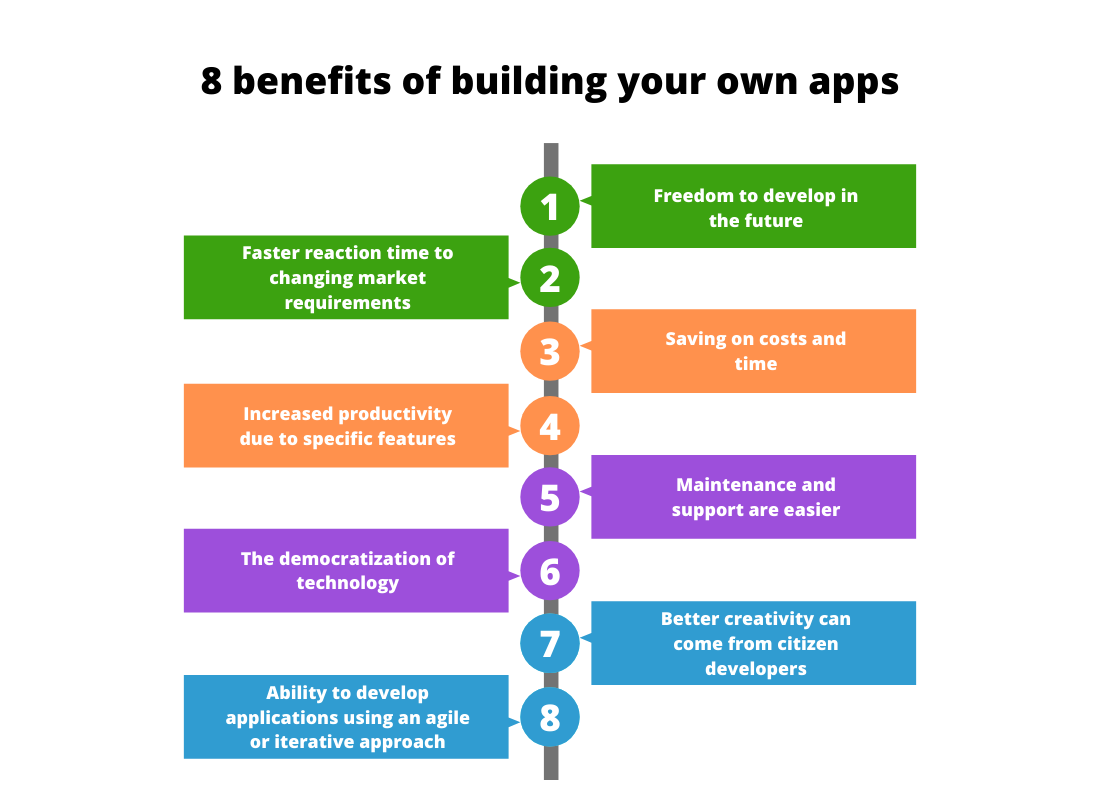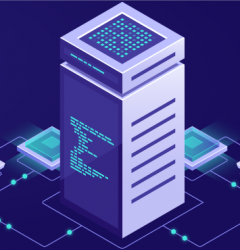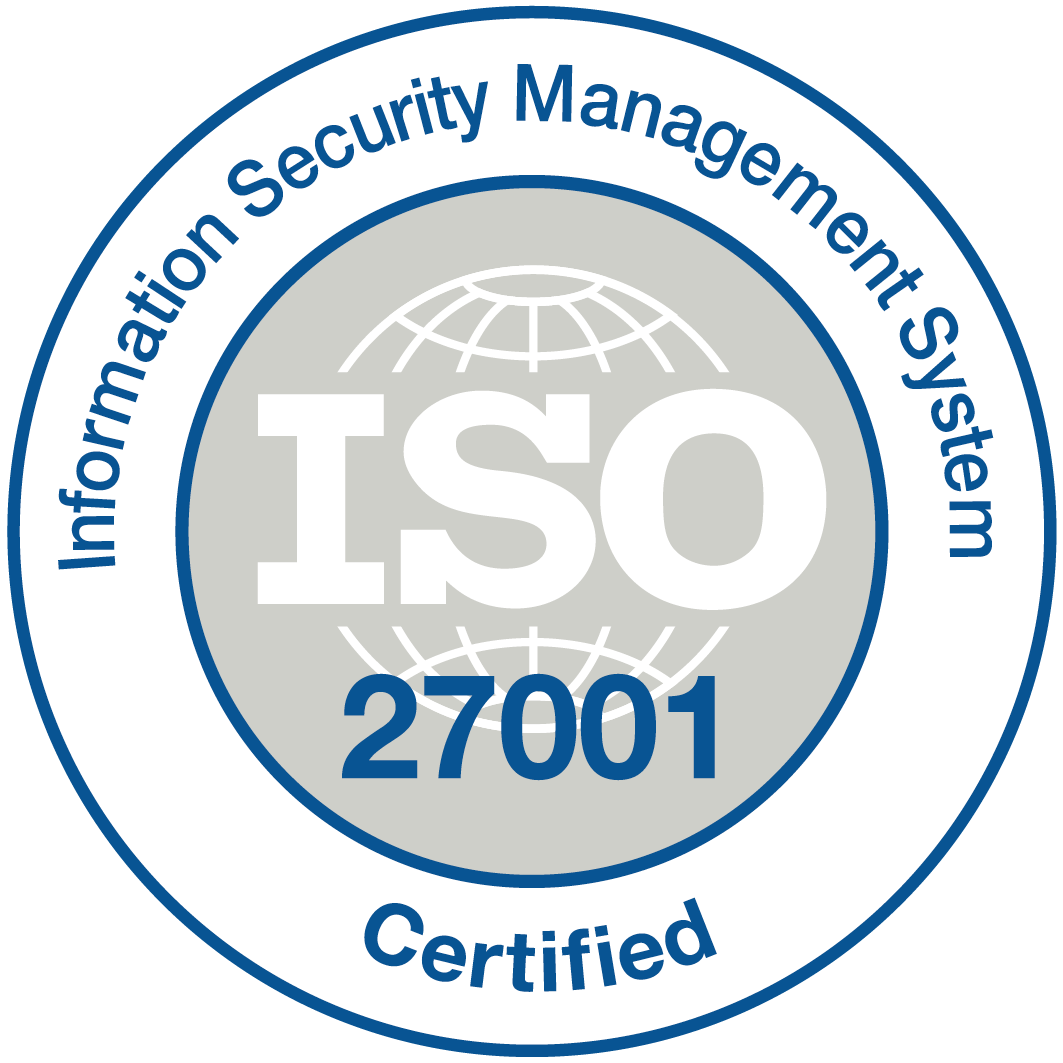
In today’s hyper-dynamic business environment, organizations are under constant pressure to meet shifting customer expectations and market demands—faster than ever before. This pressure calls for tools and applications that not only solve specific problems but also empower employees to work at their full potential.
Traditionally, the choice has been between buying a ready-made software solution or building a custom application from scratch. However, thanks to the rise of no-code development platforms, that decision is no longer as rigid—or as costly—as it once was.
📊 According to Gartner, 70% of new applications developed by enterprises will use low-code or no-code technologies, highlighting a massive shift in how businesses approach application development.
No-code tools give businesses the freedom to create apps tailored to their unique needs—faster, cheaper, and without requiring deep technical expertise. Whether you’re a startup, an enterprise, or an entrepreneur, building your own apps is no longer a luxury—it’s a competitive advantage.
In this blog, we’ll explore how to decide between building vs. buying, the types of apps typically built or purchased, and the top eight reasons why building your own apps with no-code makes more sense than ever.
Why businesses are choosing control, speed, and flexibility over off-the-shelf software.
- Rigid workflows: Off-the-shelf tools force teams to adapt their processes to the software—not the other way around.
- Slow innovation: Feature updates and changes depend on vendor timelines, slowing down progress.
- Hidden costs: Licensing, support, and customization add up over time, reducing ROI.
- Lack of control: Businesses have limited say over data handling, user access, or integrations.
- Demand for speed: Teams need to build and iterate quickly to keep up with market changes.
- Need for flexibility: Modern operations demand solutions that scale, integrate, and evolve with ease.
- Rise of no-code/low-code (LCNC): These platforms empower non-technical users to build apps, automate workflows, and customize processes without writing code.
- Strategic shift: Organizations want tools that support growth, innovation, and ownership—not just basic functionality.
How can you decide between build vs. buy regarding apps?
Build vs. buy is an ever-present decision that needs to be made by companies when they want an application for solving a particular problem. This question stems from deciding whether to build an in-house solution using IT resources (build) or buying a market-ready application as a product (buy).
Build vs. Buy is an ever-present decision that needs to be made by companies when they want an application for solving a particular problem.
This debate has often tipped in favour of buying the necessary software as building your own app or custom business solution seemed time-consuming and costly. However, with a rising change in the way that in-house solutions can be built, it’s time to reconsider the common solution of buying a ready-made software or application. The following factors can help you decide between buying products or building your own apps:

1. Costs
You need to have a good idea of how much money you have to spend on a digital solution. If you have the funds necessary to build a robust application that can help you for years down the line, building your own apps might be the correct answer to your problem.
However, with new technologies like no-code low-code, even the cost of creating applications has also been minimized.
A ready-to-use application is better for your budget, as all of the maintenance and building costs will be handled by the platform or vendor. This reduces the costs that have to be borne by you, and you can get a full-scale ready service at a feasible price.
2. Time
With ready-made tools, it’s much quicker to decide on a tool, acquire it, and then implement it. Your timeline drastically reduces, and you can get going with the new application’s capabilities quickly. However, you will still need a team to properly implement the application and handle the manual patches and features available.
With building your own application, you need to gauge whether you have the time available to wait for the application to be developed and polished enough that customers or employees can use it. This will definitely take a longer time than buying a ready-made solution unless you are using a no-code platform that can greatly accelerate the development.
3. Control
Building your own application can give your employees control over the features available in the application. This can provide them with a better chance of getting software that can solve their specific problem without creating other problems.
Buying ready-made applications mean that the employees have to settle for whichever functionalities are offered by the ready application.
4. Risk
By buying an application, you run the risk of either sharing sensitive information with those who manage the software or bugs in the system. You’ll be at the mercy of the vendor to fix any reported security, performance, or functional issues in the application.
With building your own apps, appropriate quality assurance and control checks can be put in place to avoid any security and functional issues. Even if issues arise, they can be fixed immediately.
5. Opportunities
Buying an application gives you the freedom to take up more opportunities quickly and utilize the benefits of the application quickly. Building your own app can cause valuable IT resources to be used to create this application, leading to problems with fulfilling any other requirements of the IT department. No-code platforms help address this challenge.
The Build Vs. Buy debate has often tipped in favour of buying the necessary software as building your own app or custom business solution seemed like a time-consuming and costly process. However, with a rising change in the way that in-house solutions can be built, it’s time to reconsider the easy solution of buying a ready-made software or application.
What types of applications are generally built or bought?
When deciding whether to build or buy an application, it is necessary to understand what the application is made for. Every application has a specific purpose, and the company needs to decide between building its own application to specific standards or buying an application with pre-decided features.
Generally, it is recommended that companies build applications that can help with their core competencies. The core competencies of a company can involve the main USPs of your company that differentiate you from your competitors as well as any services that you offer that are unique. If better, specific software can help your company gain a competitive advantage against the other competitors in the market, building your own application to your specific requirements might be wise.
Generally, it is recommended that companies build applications that can help with their core competencies.
Building your own applications for your core competencies will also enable you to decide which other programs to integrate with as well as build a customized solution that can suit all your needs. Building applications can also help if you have a very specialized business or business requirements that cannot be completely fulfilled by applications that are available on the market.
Building your own application may also be recommended for businesses that work in an industry with sensitive information. A built application will allow the business to complete tasks and activities without using a third-party application which could pose a security risk. However there a few issues with building applications, namely the time-restraints and rising costs of building your own custom application. Also, if requirements get changed midway, this can result in timelines extending even further.
Buying applications is recommended if you have a limited budget or limited technical proficiency. If you have a smaller budget, it might be a better idea to find a good application on the market that can fulfill some of your needs. Also, if your IT team lacks the technical expertise to develop a modern application on their own, it might be a better idea to buy an application instead of holding the IT team accountable for such a large product.
Buying applications is also ideal when you need to get an application to increase productivity in a short timeframe. If your business is in a common industry, there may be good effective applications available in the market already. If a unique application does not provide a competitive advantage in your industry, buying a robust application may be a better idea for your business.
Newer technology can definitely help you get the best of both worlds, regardless of the challenges faced in either approach of the build vs. buy question. New solutions such as no-code application development can help you build your own apps without the long timeframes and exponential costs. No-code development is also easy for anyone to do, regardless of their previous coding or programming experience. This form of application development can help lessen your IT team’s load and enable your employees to create apps to meet their needs perfectly.

How can you use no-code to build your own application?
No-code platforms can be used to build various applications, which can help you solve many problems. This form of development can help you get around many obstacles that hindered traditional development from being completed on time and within budget.
Coupled with the newer technology available such as artificial intelligence (AI), machine learning (ML), and robotic process automation (RPA), no-code development can become a fantastic way to create applications that can boost productivity. Developers are actively integrating AI into their work. Presently, 44% utilize AI tools, with 26% intending to adopt them soon. Additionally, 55% of coding learners are already employing AI tools, hinting at future widespread use among professional developers.
An enterprise-grade no-code platform can also help you consolidate and develop apps through a singular platform. This form of application development strategy can also lead to citizen developers creating applications to solve their problems, thus freeing up the IT department to focus on other strategic ventures. Using methods like no-code low-code development can help you build the application you need at a fraction of the cost and time that traditional development would require.
Building your own application through no-code technology is also ideal as you can find templates for commonly required functions. According to your unique requirements, these ready-to-use applications can later be adapted and tweaked to suit your needs. This is not possible with other readymade applications which are available to buy.
Developers are actively integrating AI into their work. Presently, 44% utilize AI tools, with 26% intending to adopt soon. Also, 55% of coding learners are already employing AI tools, hinting at future widespread use among professional developers.
How No-Code Helps You Build Smarter
No-code platforms are transforming how businesses build digital tools—without needing to write a single line of code. With drag-and-drop interfaces, visual logic builders, and prebuilt templates, they empower anyone—not just IT—to bring ideas to life faster and smarter. Here’s how:
Rapid Prototyping
No-code lets teams go from idea to working solution in a matter of days or even hours. Whether you’re building a minimum viable product (MVP) or streamlining an internal workflow, there’s no waiting on developer bandwidth or long dev cycles. Iterate faster, test sooner, and launch smarter.
AI-Powered Logic
Modern no-code platforms come equipped with AI, machine learning (ML), and robotic process automation (RPA). This means your apps don’t just automate—they also learn, adapt, and make decisions. From predictive analytics to intelligent approvals, smart features are now just a few clicks away.
Citizen Development
Empower your workforce to innovate. With no-code, business users can solve problems themselves, whether it’s building a customer intake form, a marketing request flow, or a performance tracker. This decentralizes innovation and frees up IT to focus on mission-critical work.
Template-Driven Speed
Jumpstart your projects using ready-to-use templates for CRMs, dashboards, approval flows, and more. These templates are fully customizable, so you can tweak and scale them to match your exact needs—without starting from scratch.
🧠 Stat Insight:
55% of new developers are already using AI-assisted no-code tools. As the demand for faster digital solutions grows, this trend is only accelerating.
How can different types of businesses benefit from no code?
No-code applications can help your business in a variety of ways. Regardless of scale and size, every type of business can benefit from adopting these types of applications. Small to medium-sized businesses, large businesses, and even entrepreneurs can use these applications to boost productivity and build custom applications. Here are a few ways in which no-code applications can help your business:
Small or Medium-sized businesses
Small and medium-sized businesses can use no-code application builders to solve problems in specific departments. Building your own application could also help with integrating or automating many different functions on one common platform. For example, building your own apps could help you manage HR department processes and streamline workflows in that specific department. Manual and repetitive processes can be easily automated using no code, leading to increased productivity and more efficiency in processes. For a firm Quixy was able to help them automate all of their HR and payroll processes in 2 months. This effort has enabled them to reduce the time needed for payroll processes by up to 60%!
Large Enterprises: Modern Agility, Minus the Legacy Bottlenecks
In large organizations, digital transformation often hits roadblocks due to outdated systems, complex approval chains, and limited IT capacity. No-code platforms act as a bridge—connecting modern workflows with legacy infrastructure—while empowering business teams to move faster. Here’s how:
- Reduce Reliance on IT
Free up your tech teams from handling every app request. With no-code, business units can independently create and manage their own tools—without sacrificing governance or security. - Close Cross-Departmental Gaps
Need a workflow that spans HR, Finance, and Operations? Build micro-solutions tailored to your processes without waiting on cross-functional dev sprints. - Enable Internal Teams to Innovate
From compliance tracking to budget approvals, empower your people to build exactly what they need, when they need it—all without writing code. - Integrate With Existing Systems
No-code platforms often come with built-in connectors for legacy systems, ERPs, CRMs, and cloud tools, ensuring your data flows smoothly across the enterprise.
Entrepreneurs & Startups: Build Fast. Test Faster. Grow Smart.
In the startup world, speed is everything. Whether you’re chasing your first users or scaling to Series A, no-code helps you get from idea to impact without waiting on a dev team.
Scale When You’re Ready
Start small, iterate often. Once you’ve nailed product-market fit, no-code platforms allow you to scale features, users, and workflows without a complete rebuild.
Launch Your MVP Quickly
Validate your idea with a working prototype—in days, not weeks. Save time and resources by focusing only on what your users truly need.
Gather Real Feedback Sooner
Don’t build in a vacuum. No-code lets you push live fast, so you can collect feedback, learn, and improve while your competitors are still wireframing.
Also read: The Impact of Digital Transformation on Business Performance
What are good reasons to build your own apps?
Building your own apps can be an advantage for companies, especially with the new advancements in technology. Solutions like no-code low-code have helped even the scales when it comes to the build vs. buy conundrum. Gartner predicts that low-code app platforms may account for more than 65% of application development activity. There are different advantages to building applications on your own instead of buying applications from market vendors.
Gartner predicts that low-code app platforms may account for more than 65% of application development activity.
Building your own apps can give you the following benefits:

1. Freedom to develop in the future
Building your own apps or giving your IT department a chance to build will allow you to have the freedom to develop further in the future. Even if the application is developed with a certain set of features, peripheral and additional features can always be added later depending on the changing requirements. You will also be able to add and subtract features as necessary, leading to the optimum functionality for your business.
Also Read : The Ultimate Guide to Exceptional Custom Web App Development in 2025
2. Faster reaction time to changing market requirements
Once a custom application is created, the application will be completely under the purview of the software and IT team. The IT team will know the software inside and out, which means that they are capable of changing and adding new features at any time.
This flexibility and ability to tweak the software may lead to allowing your company to remain a staunch competitor in your industry for longer. The ability to change your technology strategy may make all the difference in the future and save your company from becoming obsolete.
3. Saving on costs and time
Building your own apps can save you a lot of time and money in the long run. Buying readymade applications may seem cheaper at face value. However, you also need to consider the costs created by lacking certain needed features, which can lead to buying other applications to fill these gaps.
Building your own apps can save you a lot of time and money in the long run.
With a custom business solution, you can make sure that you have the exact functionalities that you need. Also, with recent advancements in technology, no-code business solutions are becoming more and more popular. These no-code solutions can allow you to work on a common platform as well as invite citizen developers and users from your business to create their own solutions for their problems.
4. Increased productivity due to specific features
With a custom application, your IT team can build the exact features and requirements that your employees need. With a well-designed application, your employee’s productivity can drastically increase. An application that consolidates all of the employee’s requirements can allow your employees to access all of the information and data that they need from one place, instead of requiring employees to constantly switch between multiple applications to perform their tasks.
5. Maintenance and support are easier
Considering that your IT team has built the application themselves, it’ll be easier for them to perform maintenance and make sure that the application is running smoothly. Considering that they know the ins and outs of the application, it’ll also be easier to provide support, patches, security updates, bug fixes, version upgrades, etc.
6. The democratization of technology
If your application is built using an enterprise-grade no-code platform or low-code platform, your employees can try creating their own custom applications for their specific requirements. This will also happen under the purview of the IT team on a common platform, preventing shadow IT from becoming a problem.
7. Better creativity can come from citizen developers
A citizen developer will always have a better understanding of the obstacles that are hindering them from completing their tasks efficiently. This unique understanding of their own requirements can translate into citizen developers developing the perfect tool for their needs. These citizen developers may have a creative and unique method of solving their own problems that may not occur to the IT team.
8. Ability to develop applications using an agile or iterative approach
Building your own application can allow you to develop an application using an iterative or agile approach. This can allow you to use insights from end-consumers which can help you create an application that suits all of your user’s needs.
Also read: Top 12 Benefits of No-Code App Development
How Quixy Can Help you?
The Advanced No-Code Low-Code Platform for Agile, Intelligent, and Secure App Development
Quixy goes beyond traditional no-code. It’s a future-ready LCNC platform designed to support enterprise innovation at scale—powered by AI, automation, and intelligent infrastructure.
AI-Powered Insights
Quixy integrates AI and machine learning directly into your workflows:
- Auto-generate forms, reports, and data tables using natural language prompts
- Validate logic rules and suggest improvements with built-in AI co-pilots
- Trigger smart actions based on real-time data analysis
Whether you’re streamlining operations or building predictive workflows, Quixy helps you build apps that think ahead.
Safe Innovation with Sandbox Environments
Every team needs room to experiment. Quixy’s sandbox environment enables users to:
- Prototype apps safely before pushing them live
- Test integrations, workflows, and automation rules without disrupting live operations
- Empower innovation while maintaining enterprise-grade governance
It’s the perfect space for citizen developers and IT teams to collaborate risk-free.
Geopositioning for Smarter Field Ops
Need visibility into field teams, deliveries, or remote assets? With Quixy’s geolocation and mapping tools, you can:
- Track real-time data and location-based inputs
- Automate location-triggered workflows (e.g., attendance, dispatch, audits)
- Build mobile apps that adapt to user context and geography
Ideal for logistics, facility management, and field service operations.
Built for the Modern Enterprise
Here’s what sets Quixy apart from other LCNC platforms:
- Security & Compliance-First – Role-based access, audit trails, ISO 27001 & CMMI Level 3 certified
- Extensive Integration Options – Connect seamlessly with SAP, Salesforce, legacy systems, and more
- Scalable Architecture – Build apps that support hundreds to millions of transactions
- Global-Ready – Multilingual support, geopositioning, and mobile-first design for distributed teams
Effortless Management: Simplify Control Without Compromising Power
Managing apps, users, and workflows shouldn’t require a dedicated tech team. With Quixy, you get built-in governance and visibility—so everything runs smoothly, securely, and at scale.
Centralized Control Panel
Get a unified view of all your apps, users, data models, and automation logic. With Quixy’s intuitive admin console, managing your digital operations is as easy as drag, drop, and deploy.
- Track app performance, usage metrics, and approvals in real time
- Manage user roles and permissions with a few clicks
- Automate versioning, backups, and deployment across teams
Role-Based Access & Audit Trails
Control who can see what, down to the field level. Quixy ensures granular permission settings and logs every action for full auditability—perfect for compliance-heavy industries.
- Set rules by department, geography, or hierarchy
- Maintain full traceability with built-in audit logs
- Align access with data sensitivity and organizational policies
Visual Workflow Monitoring
From approvals to escalations, Quixy lets you track every workflow stage visually—making it easier to spot delays, bottlenecks, or compliance gaps.
- Real-time dashboard views of tasks and statuses
- Automated reminders and escalations
- Built-in SLA tracking and reporting
From KFC to the Indian Navy, Quixy powers mission-critical workflows with speed, intelligence, and zero code. It’s not just a platform—it’s your digital transformation engine.
Summary
As application development becomes a necessity for various industries and businesses, the build vs. buy question will only become more and more pertinent. Buying an application that’s on the market may suit your needs if you need a solution that meets most of your requirements quickly. However, when building your own app, you get the freedom to create a program that can meet all the needs of your employees and can be developed further in the future.
Quixy is a no-code app development platform that can help your company create applications to suit your unique needs. Begin your journey towards streamlined operations and tailored apps – all with the simplicity of our platform. Get started today to harness the potential of automation.
Frequently Asked Questions(FAQs)
Q. Why choose to build apps with no-code instead of buying?
Building with no-code offers tailored solutions, allowing customization to fit exact business needs, unlike off-the-shelf solutions, which ensure specific functionalities and workflows.
Q. What advantages does no-code offer in app development?
No-code accelerates development, empowering non-technical users to create applications rapidly without coding expertise, saving time, resources, and fostering innovation.
Q. How does no-code enhance flexibility and scalability in app development?
No-code platforms enable easy modifications and updates, ensuring flexibility to adapt quickly to changing requirements and scaling applications effortlessly as businesses grow.
Q. What about cost-effectiveness in no-code app development?
No-code reduces development costs significantly as it eliminates the need for hiring specialized developers or purchasing expensive software licenses.
Q. Does no-code support future-proofing of apps?
No-code empowers businesses to evolve continuously, future-proofing apps by facilitating easy updates, integrations with new technologies, and swift adaptation to market changes.
Login
Please login to comment
0 Comments
Oldest















